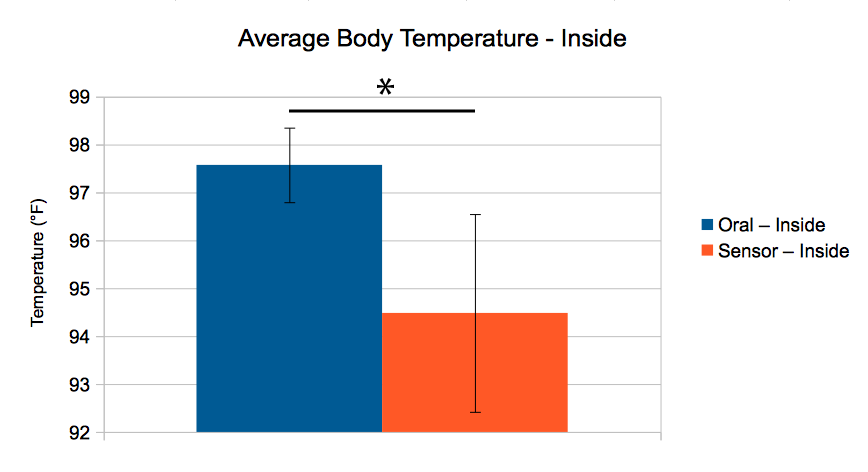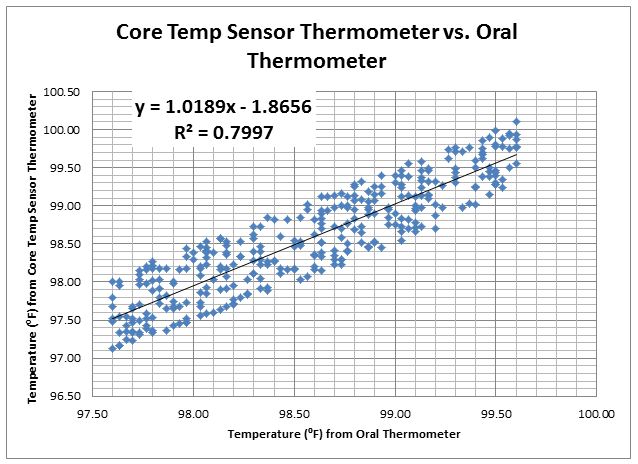BME100 f2013:W900 Group10 L3
| Home People Lab Write-Up 1 | Lab Write-Up 2 | Lab Write-Up 3 Lab Write-Up 4 | Lab Write-Up 5 | Lab Write-Up 6 Course Logistics For Instructors Photos Wiki Editing Help | |||||||
|
OUR TEAM
LAB 3A WRITE-UPDescriptive StatisticsIn this experiment, two medical devices are used to collect body temperature data. The first device used was the RAIING Medical Company Wireless Thermometer (Model: WTM-BT30-T). The other medical device used was a standard oral thermometer, the accepted standard for reading body temperature, against which we will compare the RAIING Wireless Thermometer. The table below shows the average, standard deviation, end point #'s and standard errors of body temperature for each medical device. Note that some measurements were taken in the lab under controlled conditions (not moving, etc.). These data are labeled "Inside". The rest of the data was taken outdoors during activity, and these data are labeled "Outside".
Results
Analysis
Summary/DiscussionT-Test: Analysis of the data with a t-test shows that there is a significant difference between data sets: The p-value is well below the value required to achieve significance (0.05). However, we do not want a significant difference between the data from the oral thermometer and the data from the sensor. This indicates that the sensor is not accurate. Pearson's r: The Pearson's r coefficient shows that the data has little linear correlation. This implies that that, when compared with the readings from the accepted measurement device (oral thermometer), the sensor reports widely varying and inconsistent temperature readings. Thus the sensor is imprecise. Trend Line: If the sensor were to report precise data, we would expect the slopes of the trend lines to be close to one. The slope of our trend lines are well below one, indicating that the sensor does not report precise data. Standard Deviation: If we make the assumption that our standard device (oral thermometer) is precise and that our sensor is too, then we would expect both data sets to have similar standard deviations. This is not the case, with the standard deviation being greater with the sensor data for both inside and outside data sets. This implies that our sensor reports data with more variation than the oral thermometer, indicating that the sensor is not precise. Overall lack of accuracy The sensor consistently reported body temperature lower than the oral thermometer (see scatter plots and t-test), indicating that, if we take our oral thermometer (our standard) to be accurate, the sensor is not accurate. General Issues with the Sensor While using the RAIING thermometer we encountered several design/function issues. First, we were unable to achieve wireless communication between the device and an iPhone, rendering the device useless for automatic data recording (we had to manually read off data from the on-device display). Second, the device was rather large, making it difficult to position on petite people. And third, the device had to be secured tightly to ensure proper contact with the skin, resulting in some restriction of bloodflow and skin irritation. Summary All means of analysis yielded negative results for the device. We found the sensor to be inaccurate, imprecise, uncomfortable, and unreliable as a system as a whole. Possible Device Improvements We recommend a different wireless system. Bluetooth operates on 2.4GHz which can be blocked by water, a molecule that we are full of. It might be better to use a 933MHz carrier wave and have an external receiver on the the iPhone. As the device has hard and somewhat sharp edges, it might be worth looking into a design that uses a soft rubber like material (silicone perhaps) to contain the components. This way the entire device could conform to the user's shape, making it more comfortable to wear.
LAB 3B WRITE-UPTarget Population and NeedOur target population is people who need to accurately, quickly and continuously track their core body temperature and heart rate. This includes athletes, mountaineers, rock climbers, astronauts and anyone else who works in extreme environments as well as pregnant women and medical patients. These people could be in danger of underperforming, developing health issues and or suffering serious injury or death if they fail to monitor core body temperature and heart rate. Our device offers a low profile, low weight, convenient method of tracking this information.
Device DesignOur device consist of two main pieces: A detector and a body. The detector houses an passive infrared sensor to detect the radiant heat of the skin it is attached to as well as a contact microphone to listen to the subject's heart rate. This information is passed to the body of the device through a flexible wire. The body of the device houses the battery, microprocessor and speaker. The device is worn on the ear of the subject with the body resting on the pinna and the detector is attached below the back of the jaw on top of the superficial temporal artery. The temporal artery comes directly from the heart so the blood it carries is very close to the core temperature of the heart. The device continuously measures body temperature and heart rate and gives periodic reports to the user as well as warns the user in the event of either of the parameters going beyond a preset limit. Settings, such as report intervals, volume, warning thresholds, etc. can be set via two low profile buttons (not shown on model).
Inferential StatisticsANOVA: One Way Conducting an one way ANOVA determined the null hypothesis is rejected since F > Fcrit and Pvalue < 0.05
GraphTrend Line: The trend line on the above graph shows that our device reports data in an almost one-to-one ratio to the oral thermometer, indicating that our device is accurate with respect to the standard.
| |||||||













